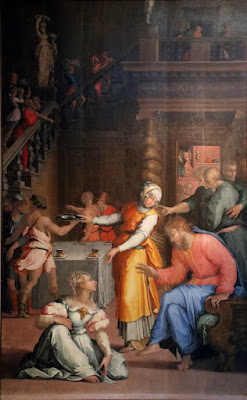 |
| Giorgio Vasari Supper of St Gregory the Great with Pilgrims 1540 oil on panel Pinacoteca Nazionale di Bologna |
 |
| Giorgio Vasari Supper of St Gregory the Great with Pilgrims (detail) 1540 oil on panel Pinacoteca Nazionale di Bologna |
 |
| Giorgio Vasari Supper of St Gregory the Great with Pilgrims (detail) 1540 oil on panel Pinacoteca Nazionale di Bologna |
 |
| Giorgio Vasari Allegory of the Immaculate Conception (Pala Altoviti) 1540-41 oil on panel Chiesa di Santi Apostoli, Florence |
 |
| Giorgio Vasari Allegory of the Immaculate Conception (detail) (Pala Altoviti) 1540-41 oil on panel Chiesa di Santi Apostoli, Florence |
 |
| Giorgio Vasari Allegory of the Immaculate Conception (detail) (Pala Altoviti) 1540-41 oil on panel Chiesa di Santi Apostoli, Florence |
 |
| Giorgio Vasari Allegory of the Immaculate Conception (detail) (Pala Altoviti) 1540-41 oil on panel Chiesa di Santi Apostoli, Florence |
 |
| Giorgio Vasari Christ in the House of Martha and Mary 1540 oil on panel Pinacoteca Nazionale di Bologna |
 |
| Giorgio Vasari Christ in the House of Martha and Mary (detail) 1540 oil on panel Pinacoteca Nazionale di Bologna |
 |
| Giorgio Vasari Temptation of St Jerome ca. 1541-48 oil on panel (unfinished) Art Institute of Chicago |
 |
| Giorgio Vasari Pietà with Saints 1548 oil on panel private collection |
 |
| Giorgio Vasari Doubting Thomas (detail) ca. 1550 oil on canvas Basilica di Santa Croce, Florence |
 |
| Giorgio Vasari Apostles Peter and John bless the People (detail) 1557 oil on canvas Gemäldegalerie, Berlin |
 |
| Giorgio Vasari The Crucifixion (detail) ca. 1560-63 oil on panel Chiesa di Santa Maria del Carmine, Florence |
 |
| Giorgio Vasari Assumption of the Virgin 1568 oil on panel Badia Fiorentina |
"Giorgio Vasari (1511-1574) – Painter, architect and art impresario, born in Arezzo but Florentine by adoption, he was the most important writer on the art of the Italian Renaissance and Mannerism. . . . Vasari's practice of art has until recently been eclipsed by his work as a writer. It was, however, both extensive and important. . . . His intellectual predilections, fostered through his humanist education alongside the young Medici heirs and his artistic training under [Baccio] Bandinelli, manifest themselves in the complex iconography and dry abstracting handling of his portraits and altarpieces."
– extracts from the Yale Dictionary of Art and Artists, Erika Langmuir and Norbert Lynton (2000)